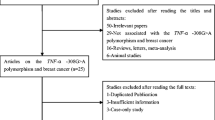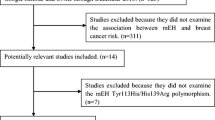Abstract
Manganese superoxide dismutase (MnSOD) has been identified as an important scavenger of reactive oxygen species (ROS), which can cause oxidative stress followed by breast cancer. A number of subsequent population-based studies have investigated the association between MnSOD Ala-9Val polymorphism and the risk of breast cancer. However, these studies have yielded conflicting results. This fact implies that the effect of MnSOD Ala-9Val polymorphism on the susceptibility to breast cancer may be modified by other risk factors. To provide a more definitive conclusion, a full meta-analysis combining and summarizing 16 studies was first performed using both traditional and Bayesian approaches. During this step, a recessive inheritance mode was determined after a biological justification. The capability of the Bayesian method was highlighted in the estimation of a pooled odds ratio and 95% confidence interval. As a result, no significant association was observed (OR = 0.978, CI = 0.914–1.046). Bayesian meta-regression and subgroup analysis were then conducted to find possible risk modifications by other factors, including menopausal status, ethnicity effect, use of oral contraceptives, use of hormone replacement therapy, fruits and vegetables intake, vitamin supplement, and body mass index. While the power of most subgroups may be insufficient to make a statistical statement, an evidence-based sample size calculation based upon updated meta-analysis was performed to power a future trial. For example, approximately 5,000 subjects are required for a new Asian study (2,500 cases and 2,500 controls) to achieve 80% power.





Similar content being viewed by others
References
Emerit I (1994) Reactive oxygen species, chromosome mutation, and cancer: possible role of clastogenic factors in carcinogenesis. Free Radic Biol Med 16:99–109
Feig DI, Reid TM, Loeb LA (1994) Reactive oxygen species in tumorigenesis. Cancer Res 54:1890s–1894s
Gilbert DL, Colton CA (1999) Reactive oxygen species in biological systems: an interdisciplinary approach. Springer, Dordrecht
Slanger TE, Chang-Claude J, Wang-Gohrke S (2006) Manganese superoxide dismutase Ala-9Val polymorphism, environmental modifiers, and risk of breast cancer in a German population. Cancer Causes Control 17:1025–1031
Kinnula VL, Crapo JD (2003) Superoxide dismutases in the lung and human lung diseases. Am J Respir Crit Care Med 167:1600–1619
Gaudet MM, Gammon MD, Santella RM, Britton JA, Teitelbaum SL, Eng SM et al (2005) MnSOD Val-9Ala genotype, pro- and anti-oxidant environmental modifiers, and breast cancer among women on Long Island, New York. Cancer Causes Control 16:1225–1234
Millikan RC, Player J, de Cotret AR, Moorman P, Pittman G, Vannappagari V et al (2004) Manganese superoxide dismutase Ala-9Val polymorphism and risk of breast cancer in a population-based case-control study of African Americans and whites. Breast Cancer Res 6:R264–R274
Rosenblum JS, Gilula NB, Lerner RA (1996) On signal sequence polymorphisms and diseases of distribution. Proc Natl Acad Sci USA 93:4471–4473
Sutton A, Khoury H, Prip-Buus C, Cepanec C, Pessayre D, Degoul F (2003) The Ala16Val genetic dimorphism modulates the import of human manganese superoxide dismutase into rat liver mitochondria. Pharmacogenetics 13:145–157
Forsberg L, de Faire U, Morgenstern R (2001) Oxidative stress, human genetic variation, and disease. Arch Biochem Biophys 389:84–93
Ambrosone CB, Freudenheim JL, Thompson PA, Bowman E, Vena JE, Marshall JR et al (1999) Manganese superoxide dismutase (MnSOD) genetic polymorphisms, dietary antioxidants, and risk of breast cancer. Cancer Res 59:602–606
Cai Q, Shu XO, Wen W, Cheng JR, Dai Q, Gao YT, Zheng W (2004) Genetic polymorphism in the manganese superoxide dismutase gene, antioxidant intake, and breast cancer risk: results from the Shanghai Breast Cancer Study. Breast Cancer Res 6:R647–R655
Egan KM, Thompson PA, Titus-Ernstoff L, Moore JH, Ambrosone CB (2003) MnSOD polymorphism and breast cancer in a population-based case–control study. Cancer Lett 199:27–33
Mitrunen K, Sillanpaa P, Kataja V, Eskelinen M, Kosma VM, Benhamou S et al (2001) Association between manganese superoxide dismutase (MnSOD) gene polymorphism and breast cancer risk. Carcinogenesis 22:827–829
Green H, Ross G, Peacock J, Owen R, Yarnold J, Houlston R (2002) Variation in the manganese superoxide dismutase gene (SOD2) is not a major cause of radiotherapy complications in breast cancer patients. Radiother Oncol 63:213–216
Knight JA, Onay UV, Wells S, Li H, Shi EJ, Andrulis IL, Ozcelik H (2004) Genetic variants of GPX1 and SOD2 and breast cancer risk at the Ontario site of the Breast Cancer Family Registry. Cancer Epidemiol Biomark Prev 13:146–149
Cheng TC, Chen ST, Huang CS, Fu YP, Yu JC, Cheng CW et al (2005) Breast cancer risk associated with genotype polymorphism of the catechol estrogen-metabolizing genes: a multigenic study on cancer susceptibility. Int J Cancer 113:345–353
Kocabas NA, Sardas S, Cholerton S, Daly AK, Elhan AH, Karakaya AE (2005) Genetic polymorphism of manganese superoxide dismutase (MnSOD) and breast cancer susceptibility. Cell Biochem Funct 23:73–76
Tamimi RM, Hankinson SE, Spiegelman D, Colditz GA, Hunter DJ (2004) Manganese superoxide dismutase polymorphism, plasma antioxidants, cigarette smoking, and risk of breast cancer. Cancer Epidemiol Biomark Prev 13:989–996
Silva SN, Cabral MN, Bezerra de Castro G, Pires M, Azevedo AP, Manita I et al (2006) Breast cancer risk and polymorphisms in genes involved in metabolism of estrogens (CYP17, HSD17beta1, COMT and MnSOD): possible protective role of MnSOD gene polymorphism Val/Ala and Ala/Ala in women that never breast fed. Oncol Rep 16:781–788
Eras-Erdogan N, Akbas E, Senli H, Kul S, Colak T (2009) Relationship between polymorphism in the manganese superoxide dismutase gene and breast cancer. Mutat Res 680:7–11
Justenhoven C, Hamann U, Schubert F, Zapatka M, Pierl CB, Rabstein S et al (2008) Breast cancer: a candidate gene approach across the estrogen metabolic pathway. Breast Cancer Res Treat 108:137–149
Cox DG, Tamimi RM, Hunter DJ (2006) Gene × Gene interaction between MnSOD and GPX-1 and breast cancer risk: a nested case-control study. BMC Cancer 6:217
Kostrykina NA, Pechkovskiy EA, Boyarskikh UA, Sushko AG, Voronina EN, Lazarev AF et al (2009) Associations of polymorphic variant of MnSOD gene with breast cancer in residents of the Altai Region. Bull Exp Biol Med 147:84–87
Baker WL, White CM, Cappelleri JC, Kluger J, Coleman CI (2009) Understanding heterogeneity in meta-analysis: the role of meta-regression. Int J Clin Pract 63:1426–1434
Sutton AJ, Cooper NJ, Jones DR, Lambert PC, Thompson JR, Abrams KR (2007) Evidence-based sample size calculations based upon updated meta-analysis. Stat Med 26:2479–2500
Minelli C, Thompson JR, Abrams KR, Thakkinstian A, Attia J (2005) The choice of a genetic model in the meta-analysis of molecular association studies. Int J Epidemiol 34:1319–1328
Chen Y, Pei J (2009) Factors influencing the association between CYP17 T34C polymorphism and the risk of breast cancer: meta-regression and subgroup analysis. Breast Cancer Res Treat 122:471–481
Ioannidis JP, Boffetta P, Little J, O’Brien TR, Uitterlinden AG, Vineis P et al (2008) Assessment of cumulative evidence on genetic associations: interim guidelines. Int J Epidemiol 37:120–132
DerSimonian R, Laird N (1986) Meta-analysis in clinical trials. Control Clin Trials 7:177–188
Mantel N, Haenszel W (1959) Statistical aspects of the analysis of data from retrospective studies of disease. J Natl Cancer Inst 22:719–748
Carlin BP, Galfand AE, Smith AFM (1992) Hierarchical Bayesian analysis of changepoint problems. Appl Stat 41:389–408
Breslow NE, Clayton DG (1993) Approximate inference in generalized linear mixed models. J Am Stat Assoc 88:9–25
Chen Y, Pei J (2009) An assessment of a TNF polymorphic marker for the risk of HCV infection: meta-analysis and a new clinical study design. Infect Genet Evol 9:1356–1363
Boston RC, Sumner AE (2003) STATA: a statistical analysis system for examining biomedical data. Adv Exp Med Biol 537:353–369
DerSimonian R, Kacker R (2007) Random-effects model for meta-analysis of clinical trials: an update. Contemp Clin Trials 28:105–114
Spiegelhalter D, Thomas A, Best N, Lunn D (2004) WinBUGS user manual, version 1.4.1
Spiegelhalter DJ, Abrams KR, Myles JP (2003) Bayesian approaches to clinical trials and health-care evaluation. Wiley, Chichester, 10391 pp
Ford D, Easton DF, Stratton M, Narod S, Goldgar D, Devilee P et al (1998) Genetic heterogeneity and penetrance analysis of the BRCA1 and BRCA2 genes in breast cancer families. The Breast Cancer Linkage Consortium. Am J Hum Genet 62:676–689
Hopper JL, Southey MC, Dite GS, Jolley DJ, Giles GG, McCredie MR et al (1999) Population-based estimate of the average age-specific cumulative risk of breast cancer for a defined set of protein-truncating mutations in BRCA1 and BRCA2. Australian Breast Cancer Family Study. Cancer Epidemiol Biomarkers Prev 8:741–747
Bennett IC, Gattas M, Teh BT (1999) The genetic basis of breast cancer and its clinical implications. Aust N Z J Surg 69:95–105
Johnson-Thompson MC, Guthrie J (2000) Ongoing research to identify environmental risk factors in breast carcinoma. Cancer 88:1224–1229
Wang LI, Miller DP, Sai Y, Liu G, Su L, Wain JC et al (2001) Manganese superoxide dismutase alanine-to-valine polymorphism at codon 16 and lung cancer risk. J Natl Cancer Inst 93:1818–1821
Hiroi S, Harada H, Nishi H, Satoh M, Nagai R, Kimura A (1999) Polymorphisms in the SOD2 and HLA-DRB1 genes are associated with nonfamilial idiopathic dilated cardiomyopathy in Japanese. Biochem Biophys Res Commun 261:332–339
Salanti G, Sanderson S, Higgins JP (2005) Obstacles and opportunities in meta-analysis of genetic association studies. Genet Med 7:13–20
Nam IS, Mengersen K, Garthwaite P (2003) Multivariate meta-analysis. Stat Med 22:2309–2333
Pansini F, Cervellati C, Guariento A, Stacchini MA, Castaldini C, Bernardi A et al (2008) Oxidative stress, body fat composition, and endocrine status in pre- and postmenopausal women. Menopause 15:112–118
Van Landeghem GF, Tabatabaie P, Kucinskas V, Saha N, Beckman G (1999) Ethnic variation in the mitochondrial targeting sequence polymorphism of MnSOD. Hum Hered 49:190–193
Hayashi I, Morishita Y, Imai K, Nakamura M, Nakachi K, Hayashi T (2007) High-throughput spectrophotometric assay of reactive oxygen species in serum. Mutat Res 631:55–61
Huang MC, Chen CH, Peng FC, Tang SH, Chen CC (2009) Alterations in oxidative stress status during early alcohol withdrawal in alcoholic patients. J Formos Med Assoc 108:560–569
Ambrosone CB, Ahn J, Singh KK, Rezaishiraz H, Furberg H, Sweeney C et al (2005) Polymorphisms in genes related to oxidative stress (MPO, MnSOD, CAT) and survival after treatment for breast cancer. Cancer Res 65:1105–1111
Li H, Kantoff PW, Giovannucci E, Leitzmann MF, Gaziano JM, Stampfer MJ, Ma J (2005) Manganese superoxide dismutase polymorphism, prediagnostic antioxidant status, and risk of clinical significant prostate cancer. Cancer Res 65:2498–2504
Bandy B, Davison AJ (1990) Mitochondrial mutations may increase oxidative stress: implications for carcinogenesis and aging? Free Radic Biol Med 8:523–539
Arsova-Sarafinovska Z, Matevska N, Eken A, Petrovski D, Banev S, Dzikova S et al (2009) Glutathione peroxidase 1 (GPX1) genetic polymorphism, erythrocyte GPX activity, and prostate cancer risk. Int Urol Nephrol 41:63–70
Berry DA (2006) Bayesian clinical trials. Nat Rev Drug Discov 5:27–36
Acknowledgement
National Natural Science Fund (20905037), Jiangsu Natural Science Fund (BK2009419), and Research fund for the doctoral program of higher education of China (20093234120010) to Dr. Chen are gratefully acknowledged. The authors would also like to thank Chen Jie for his support in data processing.
Author information
Authors and Affiliations
Corresponding author
Electronic supplementary material
Below is the link to the electronic supplementary material.
Fig. 1S
Cumulative meta-analysis (by sample size) for association between the MnSOD Ala-9Val polymorphism and the risk of breast cancer. The odds ratio and its 95% confidence interval were computed accumulatively (PPT 469 kb)
Fig. 2S
Posterior distribution of mean and standard deviation of pooled odds ratio and between-study variance (τ2) from the full Bayes model (PPT 82 kb)
Fig. 3S
The frequencies of Ala/Ala genotype carriers in control groups of Asian and non-Asian women (PPT 61 kb)
Rights and permissions
About this article
Cite this article
Chen, Y., Pei, J. Possible risk modifications in the association between MnSOD Ala-9Val polymorphism and breast cancer risk: subgroup analysis and evidence-based sample size calculation for a future trial. Breast Cancer Res Treat 125, 495–504 (2011). https://doi.org/10.1007/s10549-010-0978-9
Received:
Accepted:
Published:
Issue Date:
DOI: https://doi.org/10.1007/s10549-010-0978-9




